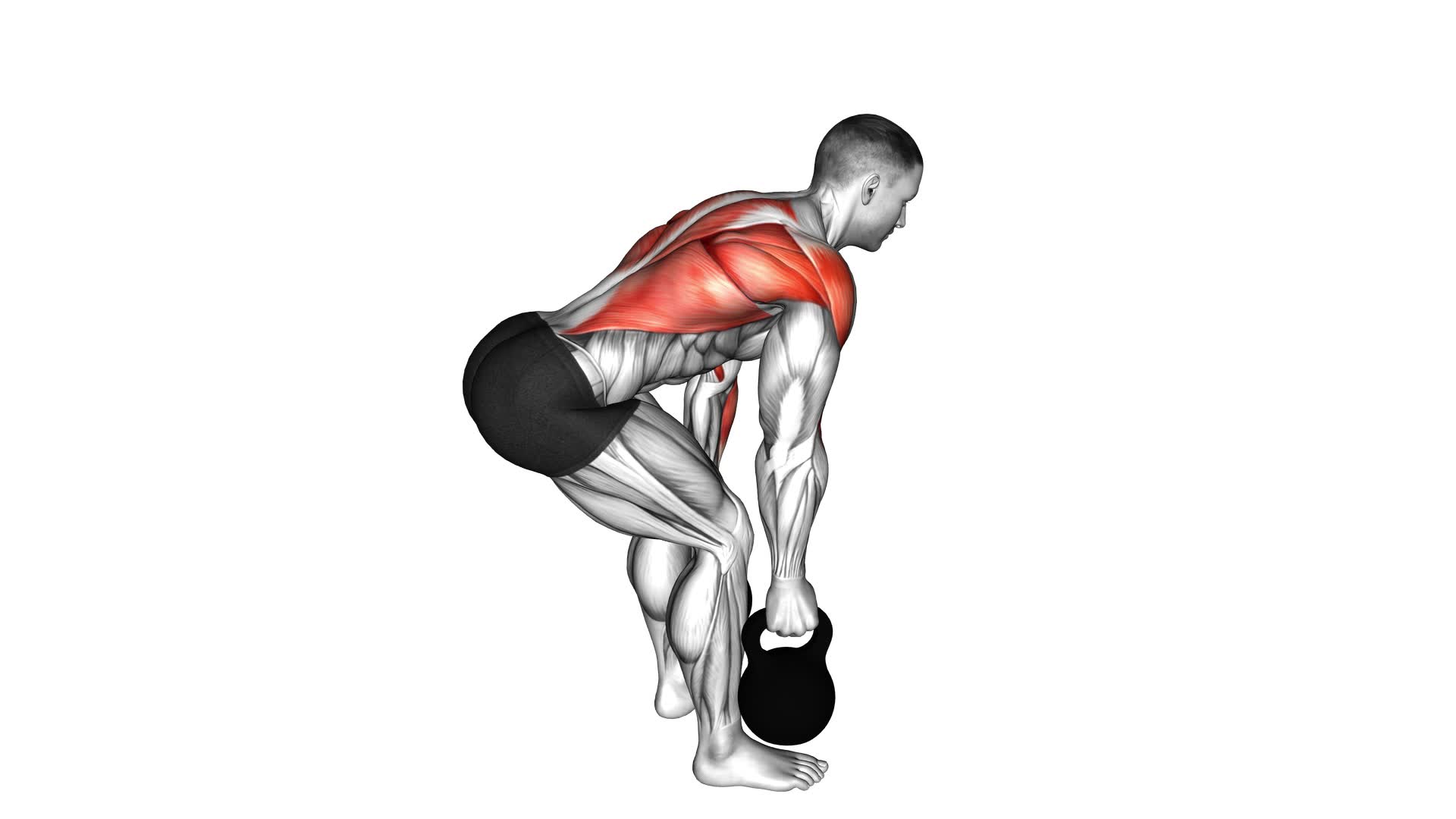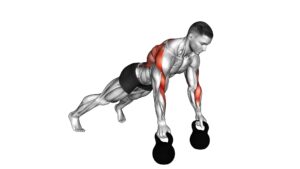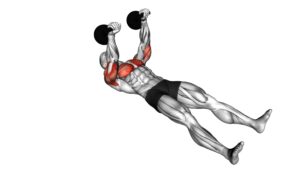Kettlebell Alternating Row – Video Exercise Guide & Tips

Are you looking for a challenging and effective exercise to add to your workout routine? Look no further than the kettlebell alternating row.
Watch This Exercise Video
This exercise targets your back and arms, helping to improve strength and posture.
In this article, you'll find a video exercise guide and valuable tips to ensure you're performing the kettlebell alternating row correctly.
Discover variations to challenge yourself, common mistakes to avoid, and how to maximize your results with this powerful exercise.
Key Takeaways
- The kettlebell alternating row exercise improves posture, builds upper body strength, and targets the back, shoulders, and arms.
- Proper form and technique, including maintaining a neutral spine and using efficient breathing techniques, are essential for maximizing the benefits of this exercise.
- Gradually increasing resistance over time challenges the muscles and promotes strength and muscle growth.
- Progression in resistance training and maintaining proper technique and mind-muscle connection are important for optimal results.
Benefits of the Kettlebell Alternating Row
You will frequently experience the benefits of the Kettlebell Alternating Row, which includes improving posture and building upper body strength. This exercise is highly effective in targeting your back, shoulders, and arms, helping to correct any imbalances and promote a more upright posture. By strengthening the muscles in your upper body, you can alleviate strain on your spine and reduce the risk of developing poor posture or back pain.
The Kettlebell Alternating Row is a compound exercise that engages multiple muscle groups simultaneously. As you row the kettlebell up towards your chest, you activate your latissimus dorsi, rhomboids, and trapezius muscles, which are responsible for pulling your shoulders back and improving your overall posture. Additionally, this exercise also targets your biceps and forearms, contributing to the development of a strong and defined upper body.
Incorporating the Kettlebell Alternating Row into your workout routine can lead to significant improvements in your posture and upper body strength. It's crucial, however, to perform this exercise with proper form and technique to maximize its benefits and prevent injury.
Proper Form and Technique for the Exercise
To ensure maximum benefits and prevent injury, it's essential to execute the Kettlebell Alternating Row with proper form and technique. Here are some important tips to keep in mind:
- Maintain a neutral spine: Keep your back straight and avoid rounding or arching your back, as this can strain the muscles and lead to injury. Engage your core and focus on a strong, stable posture throughout the exercise.
- Use efficient breathing techniques: Inhale as you lower the kettlebell and exhale as you lift it, using your breath to help generate power and stability. This will also ensure that you're engaging your core effectively.
- Maintain proper grip: Hold the kettlebell with a firm grip, making sure your hand is centered on the handle. This will help you maintain control and prevent the kettlebell from slipping or swinging out of your hand.
- Gradually increase resistance: Start with a kettlebell weight that challenges you but allows for proper form. As you become more comfortable and proficient with the exercise, gradually increase the weight to continue progressing and building strength.
Variations to Challenge Yourself
To challenge yourself, consider trying different variations of the Kettlebell Alternating Row exercise. By incorporating these variations into your routine, you can increase the difficulty of the exercise and improve your grip strength.
One variation you can try is the single-arm kettlebell row. Instead of alternating arms, you'll perform the row with one arm at a time. This variation not only challenges your back muscles but also requires more control and stability.
Another variation is the renegade row. In this exercise, you start in a plank position with your hands on two kettlebells. From there, you pull one kettlebell up towards your chest while keeping your body stable. This variation not only targets your back muscles but also engages your core and shoulders.
You can also try performing the kettlebell row on an unstable surface, such as a Bosu ball or a balance board. This forces your muscles to work harder to stabilize your body, increasing the difficulty of the exercise.
Incorporating these variations into your routine won't only challenge your muscles but also improve your grip strength. So, don't be afraid to mix things up and try something new to take your kettlebell alternating row to the next level.
Common Mistakes to Avoid
Avoiding common mistakes is crucial when performing the Kettlebell Alternating Row exercise. To ensure you get the most out of your workout and minimize the risk of injury, be mindful of the following:
- Using improper form: One of the most common mistakes isn't maintaining a neutral spine. Avoid rounding your back or hunching your shoulders. Keep your core engaged and your back straight throughout the movement.
- Neglecting proper breathing: Breathing plays a vital role in any exercise. Many people forget to breathe properly during the Kettlebell Alternating Row, which can lead to decreased performance and potential strain. Remember to inhale as you lower the kettlebell and exhale as you lift it.
- Lifting too heavy: It's essential to choose a weight that allows you to maintain proper form and complete the exercise with control. Lifting a weight that's too heavy can compromise your technique and increase the risk of injury.
- Rushing the exercise: Take your time with each repetition. Rushing through the Kettlebell Alternating Row can lead to sloppy form and reduced effectiveness. Focus on the quality of your movement rather than the quantity.
How to Incorporate the Kettlebell Alternating Row Into Your Workout Routine
How can you effectively incorporate the Kettlebell Alternating Row into your workout routine?
This exercise is a great way to build strength and improve your overall fitness. One way to incorporate the Kettlebell Alternating Row is by adding it to your upper body or back workout.
Start by selecting a kettlebell that challenges you but still allows you to maintain proper form. Begin in a standing position with your feet shoulder-width apart and the kettlebell in one hand.
Hinge forward at the hips while keeping your back straight and core engaged. As you do this, lift the kettlebell towards your ribcage, focusing on squeezing your shoulder blades together. Lower the kettlebell back down and repeat on the opposite side.
Incorporating kettlebell exercises like the Alternating Row into your workout routine can provide numerous benefits. Rowing workouts can help improve your posture, strengthen your back and shoulders, and increase overall upper body strength.
Tips for Maximizing Your Results With This Exercise
To maximize your results with the kettlebell alternating row, focus on maintaining proper form throughout the exercise. Keep your back straight, core engaged, and shoulders pulled back.
Additionally, practice efficient breathing techniques, exhaling as you lift the kettlebell and inhaling as you lower it.
Lastly, gradually increase the resistance over time by using a heavier kettlebell or adding more repetitions to challenge your muscles and continue progressing.
Proper Form Techniques
To maximize your results with the kettlebell alternating row exercise, focus on maintaining proper form and technique. Here are some tips to help you get the most out of this exercise:
- Keep your back straight and your core engaged throughout the movement. This will help you maintain stability and prevent injury.
- Pull the kettlebell towards your chest in a controlled manner, squeezing your shoulder blades together at the top of the movement.
- Avoid using momentum to lift the weight. Instead, focus on using your back muscles to perform the rowing motion.
- Gradually increase the weight of the kettlebell as you get stronger. This will help challenge your muscles and promote growth.
By following these proper form techniques, you can ensure that you're maximizing the effectiveness of the kettlebell alternating row exercise.
Now, let's move on to discuss efficient breathing techniques.
Efficient Breathing Techniques
To optimize your results with the kettlebell alternating row exercise, continue focusing on proper form and technique. Incorporating efficient breathing techniques can play a crucial role in maximizing the benefits of this exercise.
By practicing mindful breathing, you can enhance your performance and increase your endurance. As you pull the kettlebell towards your body, exhale to engage your core and stabilize your spine. Inhale as you lower the kettlebell back down to the starting position.
This controlled breathing pattern helps maintain stability and control throughout the movement. By being mindful of your breath, you can enhance your mind-muscle connection and ensure that you're using the correct muscles during the exercise.
Incorporating efficient breathing techniques will help you achieve optimal results from the kettlebell alternating row exercise.
Increasing Resistance Over Time
To maximize your results with the kettlebell alternating row exercise and continue building strength and muscle, it's important to gradually increase the resistance over time. Progression is key in resistance training, as it challenges your muscles to adapt and grow stronger.
Here are some tips for increasing resistance effectively:
- Start with a weight that allows you to complete the exercise with proper form and technique.
- Once you can perform the exercise comfortably, gradually increase the weight by 5-10%.
- Aim to increase the resistance every 1-2 weeks, depending on your progress and abilities.
- Listen to your body and adjust the weight accordingly to prevent injury and ensure continuous progress.
Frequently Asked Questions
How Heavy Should the Kettlebell Be for the Alternating Row Exercise?
When doing the alternating row exercise with kettlebells, it's important to choose the right weight. The kettlebell weight should challenge you, but still allow you to maintain proper form throughout the exercise.
Start with a weight that you can comfortably lift for 8-12 repetitions. As you get stronger, gradually increase the weight to continue challenging your muscles.
Can the Kettlebell Alternating Row Exercise Be Done With Dumbbells Instead?
Yes, you can do the kettlebell alternating row exercise with dumbbells instead. Dumbbell row variations are a great alternative to kettlebell exercises. They provide similar benefits, such as improving upper body strength and targeting the muscles in your back, arms, and shoulders.
Dumbbell rows can also be done with a variety of grip positions, allowing you to target different muscle groups. So, if you don't have access to kettlebells, dumbbells are a great alternative for the alternating row exercise.
Is There a Specific Breathing Pattern to Follow During the Kettlebell Alternating Row Exercise?
When performing the kettlebell alternating row exercise, it's important to maintain a specific breathing pattern to ensure proper form and maximize your results.
By exhaling as you pull the kettlebell up towards your chest and inhaling as you lower it back down, you engage your core and stabilize your body.
This breathing technique helps you maintain control and focus throughout the exercise, allowing you to get the most out of each rep.
How Often Should the Kettlebell Alternating Row Exercise Be Performed?
To get the most out of the kettlebell alternating row exercise, it's important to know how often to do it. The frequency of the kettlebell alternating row will depend on your fitness goals and current level of strength.
Generally, it's recommended to perform this exercise 2-3 times a week. By incorporating this exercise into your routine, you can benefit from improved upper body strength, posture, and core stability.
Are There Any Modifications for Individuals With Lower Back Pain or Injuries?
If you experience lower back pain or have a back injury, there are modifications you can make while performing the kettlebell alternating row exercise. It's important to prioritize your safety and avoid aggravating your condition.
Common mistakes to avoid include using too heavy of a kettlebell, rounding your back, and pulling with your arms instead of engaging your back muscles.
Conclusion
The kettlebell alternating row is a great exercise for building upper body strength and improving posture. By using proper form and technique, you can effectively target your back muscles and increase stability.
To challenge yourself, try variations such as using heavier weights or performing the exercise on an unstable surface. Avoid common mistakes like rounding your back or using momentum to lift the kettlebell.
Incorporate the kettlebell alternating row into your workout routine to see maximum results.

Author
Years ago, the spark of my life’s passion ignited in my mind the moment I stepped into the local gym for the first time. The inaugural bead of perspiration, the initial endeavor, the very first surge of endorphins, and a sense of pride that washed over me post-workout marked the beginning of my deep-seated interest in strength sports, fitness, and sports nutrition. This very curiosity blossomed rapidly into a profound fascination, propelling me to earn a Master’s degree in Physical Education from the Academy of Physical Education in Krakow, followed by a Sports Manager diploma from the Jagiellonian University. My journey of growth led me to gain more specialized qualifications, such as being a certified personal trainer with a focus on sports dietetics, a lifeguard, and an instructor for wellness and corrective gymnastics. Theoretical knowledge paired seamlessly with practical experience, reinforcing my belief that the transformation of individuals under my guidance was also a reflection of my personal growth. This belief holds true even today. Each day, I strive to push the boundaries and explore new realms. These realms gently elevate me to greater heights. The unique combination of passion for my field and the continuous quest for growth fuels my drive to break new ground.







